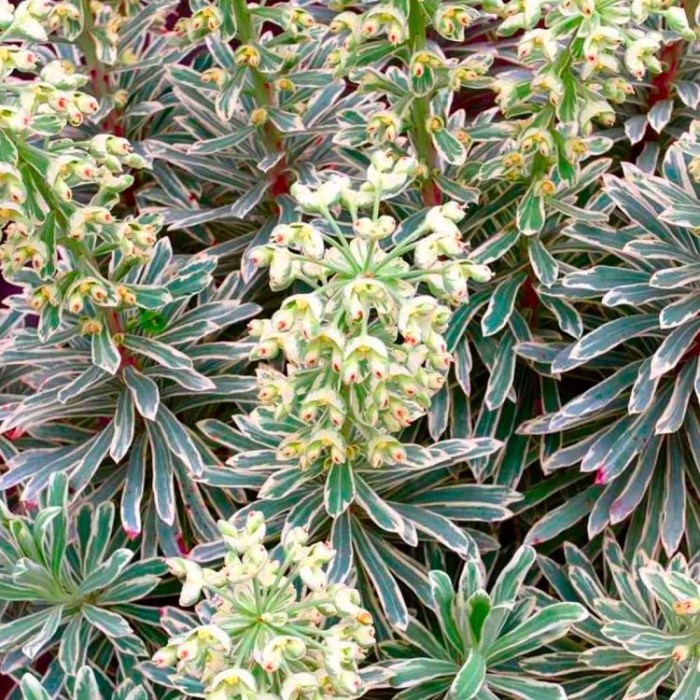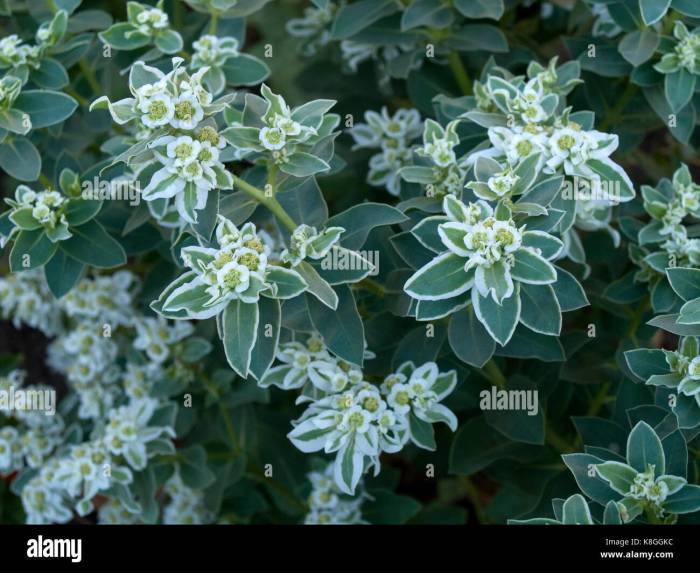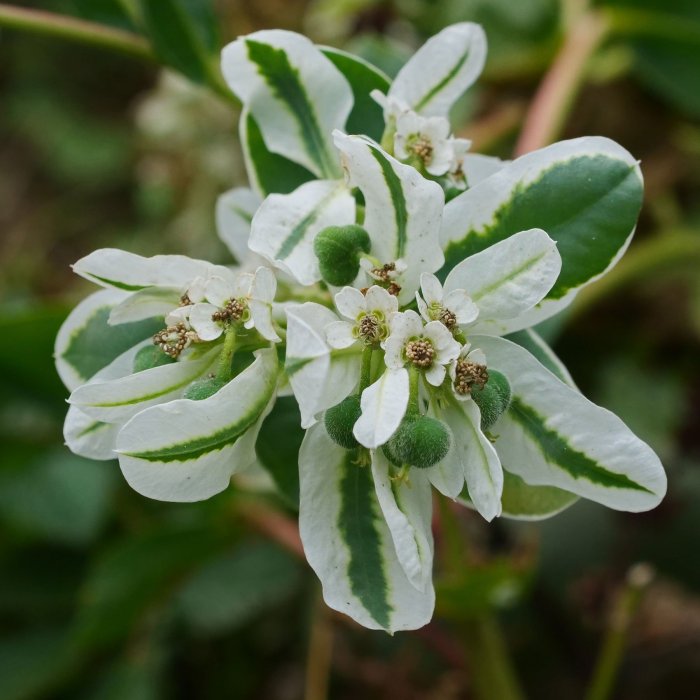In the realm of variegated plants, Euphorbia stands out with its vibrant and intricate foliage. This guide delves into the world of Euphorbia variegated, exploring its distinctive characteristics, cultivation techniques, and ornamental value.
From the stunning patterns of Euphorbia lactea ‘Cristata’ to the vibrant hues of Euphorbia tirucalli ‘Sticks on Fire’, variegated Euphorbia species captivate with their unique beauty.
Euphorbia Variegated Plant Characteristics

Euphorbia variegated plants are renowned for their captivating foliage patterns and colors, making them highly sought-after additions to indoor and outdoor gardens. These variegated varieties exhibit unique patterns and color combinations that distinguish them from their non-variegated counterparts.
Examples of Different Variegated Euphorbia Species
The world of variegated euphorbia boasts a diverse array of species, each with its own distinctive features:
- Euphorbia tirucalli‘Variegata’: This succulent shrub displays pencil-like stems adorned with creamy-white variegation.
- Euphorbia milii‘Variegata’: Known for its showy bracts, this variety exhibits bright yellow or cream variegation.
- Euphorbia lactea‘Cristata’: A unique crested form with wavy, fan-shaped branches in shades of green and yellow.
Factors Influencing Variegation in Euphorbia Plants
The variegation patterns in euphorbia plants are influenced by several factors:
- Genetics:The genetic makeup of the plant determines the potential for variegation.
- Light:Adequate sunlight promotes the production of chlorophyll, which contributes to the green color of leaves. Variegated plants may require slightly more light than their non-variegated counterparts.
- Nutrients:Nitrogen deficiency can lead to reduced variegation, while phosphorus and potassium are essential for overall plant health.
- Temperature:Cooler temperatures can enhance variegation in some species, while warmer temperatures may promote a more uniform green color.
Care and Cultivation of Variegated Euphorbia: Euphorbia Variegated

Nurturing variegated euphorbia requires specific care to ensure optimal growth and maintain their captivating foliage. Understanding their light, water, and soil requirements is crucial, along with proper propagation techniques. By following these guidelines, you can cultivate healthy and vibrant variegated euphorbia plants that add a touch of exotic beauty to your living space.
Light Requirements
Variegated euphorbia thrives in bright, indirect light. Direct sunlight can scorch their leaves, leading to discoloration and damage. East- or west-facing windows provide ideal lighting conditions, allowing them to receive ample sunlight without excessive exposure.
Water Requirements
Water variegated euphorbia sparingly, allowing the soil to dry out completely between waterings. Overwatering can lead to root rot, which can be fatal to the plant. During the growing season (spring and summer), water when the top inch of soil feels dry to the touch.
Reduce watering during the winter months when growth slows down.
Soil Requirements
Variegated euphorbia prefers well-draining soil with a pH between 5.5 and 6.5. A cactus or succulent potting mix is an excellent choice, as it provides the necessary drainage and aeration for healthy root development.
Euphorbia variegated, a popular succulent, requires specific care to thrive. For optimal growth, it is crucial to provide a well-draining soil mixture. Bunnings Orchid Soil: The Ultimate Guide to Nurturing Your Orchids offers valuable insights into orchid soil composition and provides recommendations for euphorbia variegated cultivation.
Understanding the soil requirements of this vibrant succulent ensures its health and longevity.
Propagation
Variegated euphorbia can be propagated through stem cuttings or seeds. To propagate through cuttings, take a healthy stem cutting and allow it to callous over for a few days. Plant the cutting in well-draining soil and keep it moist until new roots form.
To propagate through seeds, sow them in a seed tray filled with a cactus or succulent potting mix. Keep the seeds moist and provide bright, indirect light until germination occurs.
Pest and Disease Management
Variegated euphorbia is generally pest-resistant, but they can occasionally be affected by mealybugs, spider mites, or aphids. Inspect your plants regularly and treat any infestations promptly with an appropriate insecticide. To prevent diseases, ensure proper watering and drainage to avoid root rot.
Fungal diseases can be treated with a fungicide if necessary.
Uses and Benefits of Variegated Euphorbia
Beyond its aesthetic appeal, variegated euphorbia offers potential medicinal properties and cultural significance in various regions.
Ornamental Value
The variegated euphorbia’s vibrant foliage and striking patterns make it a popular choice for landscaping and interior design. Its versatility extends from outdoor gardens and borders to indoor containers and hanging baskets, adding a touch of color and interest to any space.
Medicinal Properties
Although scientific evidence is limited, some traditional medicine practitioners believe that variegated euphorbia possesses medicinal properties. Extracts from the plant have been used to treat conditions such as skin ailments, wounds, and digestive issues. However, it’s crucial to note that these claims require further scientific validation.
Cultural Significance
In certain cultures, variegated euphorbia holds symbolic and historical significance. In some parts of Africa, it’s believed to ward off evil spirits and bring good luck. In other regions, it’s used in traditional ceremonies and rituals, representing purity and protection.
Design Ideas and Inspirations

Variegated euphorbia’s striking foliage and architectural form make it a versatile design element in various settings. From gardens to patios and indoor spaces, this plant offers unique and eye-catching arrangements.
Whether used as a focal point or a complementary accent, variegated euphorbia adds a touch of elegance and sophistication to any space. Its variegated leaves, ranging from shades of green to yellow and cream, create a dynamic visual interest.
Euphorbia variegated is a popular succulent known for its colorful foliage and low maintenance requirements. Its unique appearance makes it an attractive addition to any home or garden. For those looking to showcase their euphorbia variegated, Bunnings Outdoor Ceramic Pots: A Comprehensive Guide to Styling Planting and Care provides valuable insights into choosing the right pots, planting techniques, and care tips to ensure optimal growth and visual appeal for your euphorbia variegated.
Garden Designs, Euphorbia variegated
In gardens, variegated euphorbia can be used as a specimen plant, showcased in a prominent location to draw attention to its unique foliage. It can also be planted in mass to create a stunning groundcover or used as an edging plant to define borders.
Euphorbia variegated, a succulent plant known for its vibrant foliage, is a popular choice for hanging baskets. Its trailing stems and variegated leaves create a cascading effect, making it an attractive addition to any indoor space. For those looking to purchase hanging plants, hanging plants bunnings offers a wide selection of euphorbia variegated and other hanging plants to suit any decor.
When combined with other plants, variegated euphorbia creates a harmonious contrast. Its upright growth habit and variegated leaves complement low-growing plants with contrasting textures and colors, such as creeping thyme or sedum.
Euphorbia variegated is a striking plant known for its vibrant foliage and easy care. Whether you’re looking to add a touch of color to your home or are new to the world of gardening, this plant is an excellent choice.
For more inspiration on how to incorporate plants into your home décor, check out Discover the Enchanting World of Bunnings Plant Baskets: A Guide to Types Uses and Care . Euphorbia variegated is a versatile plant that can thrive in a variety of settings, making it a perfect choice for any plant enthusiast.
Patio Designs
On patios, variegated euphorbia thrives in containers, bringing a touch of nature to outdoor living spaces. Its compact size makes it suitable for small balconies and patios, where it can add a pop of color and interest.
Consider using variegated euphorbia in hanging baskets or wall-mounted planters to create a vertical accent. Its trailing stems and variegated leaves will cascade gracefully, adding a touch of elegance to any outdoor setting.
Indoor Designs
Indoors, variegated euphorbia is a popular choice for adding a touch of greenery and architectural interest. Its compact size and adaptability to low-light conditions make it suitable for various indoor spaces, from living rooms to offices.
Place variegated euphorbia on a shelf or table to create a focal point. Its unique foliage will add visual interest and complement other indoor plants or decor.
Comparison to Similar Plants
Variegated euphorbia, with its striking foliage and easy-care nature, stands out among other variegated plants. Let’s explore its key differences and similarities with two popular variegated varieties: variegated croton and variegated ivy.
Appearance
- Variegated Euphorbia:Displaying a stunning array of green, white, yellow, and pink hues, variegated euphorbia boasts bold and intricate patterns on its leaves.
- Variegated Croton:Known for its vibrant and diverse foliage, variegated croton features a kaleidoscope of colors, including shades of green, yellow, orange, red, and purple.
- Variegated Ivy:With its elegant cascading vines, variegated ivy exhibits a subtle variegation, primarily consisting of shades of green with creamy white or yellow accents.
Care Requirements
- Variegated Euphorbia:Thrives in bright, indirect light and prefers well-draining soil. It tolerates some drought but requires regular watering during the growing season.
- Variegated Croton:Demands bright, indirect light and high humidity. It requires consistent watering and prefers moist soil.
- Variegated Ivy:Adaptable to various light conditions, variegated ivy thrives in both bright indirect light and shady areas. It prefers well-draining soil and regular watering.
Uses
- Variegated Euphorbia:Ideal as a focal point in indoor settings, adding a touch of drama and color. It can also be used as an accent plant in outdoor gardens.
- Variegated Croton:Commonly used as a statement piece in tropical gardens and conservatories, adding vibrant hues and a touch of the exotic.
- Variegated Ivy:Perfect for adding greenery and a touch of elegance to hanging baskets, terrariums, and indoor spaces with low light conditions.
Epilogue

Whether adorning landscapes or adding a touch of elegance to indoor spaces, Euphorbia variegated offers a captivating blend of beauty and versatility. Its ease of care and potential medicinal properties make it an ideal choice for both novice and experienced gardeners alike.
General Inquiries
How do I propagate variegated Euphorbia?
Variegated Euphorbia can be propagated through cuttings or seeds. Cuttings should be taken in the spring or summer, while seeds can be sown in the spring or fall.
What are the light requirements for variegated Euphorbia?
Variegated Euphorbia prefers bright, indirect light. Avoid placing it in direct sunlight, as this can scorch the leaves.
How often should I water variegated Euphorbia?
Water variegated Euphorbia when the soil is dry to the touch. Avoid overwatering, as this can lead to root rot.